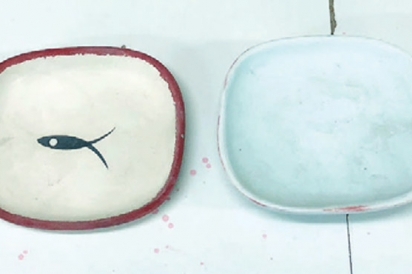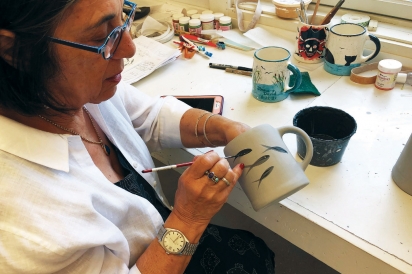Jobi Pottery
“Jobi Pottery is a legacy business,” explains Susan Kurtzman, owner of the iconic pottery line for the past 15 years. “I am only the third owner since it was founded in 1953. Joe Colliano (of originators Joe and Bill — Jo-bi) came out of retirement at age 78 to show me the process. Steve Locke, the son of the second owners, has worked with me as production manager since I bought the business.” Kurtzman’s son even worked as a designer for a bit before returning to California.
Kurtzman met Colliano after he helped save the Highland House Hotel in Truro from being razed. The hotel was bought by the Cape Cod National Seashore due to Colliano’s letter-writing persistence, and turned it into a museum. Kurtzman was the museum director. Upon learning the story of Jobi Pottery and that the business was for sale, she decided to revisit her ceramics degree from Berkeley and become a potter again. “The fifties were my era. I love the retro designs and the vintage vibe,” she said.
The first design that Colliano taught her to paint was cattails, and he also showed her how to do sgraffito. From the Italian word graffiare meaning “to scratch”, sgraffito is the art of scratching a design in the pottery by removing (or scratching) the one layer of underglaze to create a contrasting design or pattern on the leather hard clay. Every single one of the pottery’s signature black minnows are freehand painted by Kurtzman. This is truly a labor of love, as they appear on almost every piece, usually in a school. Jobi Pottery still makes the original 22 designs, now copyrighted, that “the Jobis” — as Kurtzman refers to them — made. She has added new designs — a pirate, an anchor, a mermaid — and brightened up the colors. She designed a colorful fish pattern, the iconic black fish on a watercolor-esque background, and “swipes the stripes” while listening to music. The rainbows and fishes design was created by Truro resident Ed Christie, a designer-builder of Jim Henson’s Muppets. The spattered background on some of the original designs is ‘very fifties’. Says Kurtzman, “So we only use that on vintage designs.” She trademarked the Jobi name and owns all the old Jobi signs which are displayed in the Route 6 Truro shop.
She continually does color testing to keep the color palette consistent. Glaze manufacturers are constantly discontinuing colors and when people add pieces to a collection, they want the same color. The glaze must be food-safe, non-toxic and lead-free, which limits the offerings.
Six years ago, she moved the shop from two miles down the road but kept the kilns there as they are not allowed in the Route 6 space. She turned the shop into her home and kept the garage for the production center.
Locke and Kurtzman concur that each piece is touched by human hands at least nine times before being brought to the store. First the slip, raw gray clay, is prepared to a certain viscosity and pumped out of a hose; the molds are set out and filled to the top. Excess clay is poured out after a short drying period — an art and a science to the thickness, done by eye. At the end of the day, the clay is taken out of the mold and a sponge or knife is used to knock off the bits and bumps. They are painted with colored slip, the underglaze, air dried for 24 hours, and then fired at 1940 degrees Fahrenheit. This first fire in the bisque kiln releases moisture and gases and the gray color turns to white. After cooling, they are painted and dipped or hand-painted in overglaze. The silica-based overglaze is lightly colored to show the “holidays”, or missed spots. The pieces are “stilted” in the final fire — put on stilts — at a lower 1840 degrees Fahrenheit, to minimize contact with the kiln. Shelves are created with larger stilts to increase capacity. Between each step the pottery sits for 12 to 24 hours. A Dremel is used to gently smooth off any bits left from the stilts.
Kurtzman bought 250 plaster molds with the business, but they need to be replaced occasionally due to cracking, so she learned to make her own. “Thank you, You Tube!” she chuckles. Ready-made, hand-made slip casting molds is an obsolete business.
There are rarely seconds, or pieces that are less than perfect, but the few they do have are offered at a “seconds sale” around Kurtzman’s July birthday. The shop also serves as a gallery for eight local artists of varying visual arts so there is a lot to see. When you go, Kurtzman will welcome you, ask if you have ever been there and give you a synopsis of “the Jobi story.”
Jobi Pottery was recently chosen by State Senator and Truro resident Julian Cyr, to have a piece in “Artists Under the Dome” at the Massachusetts State House. Well-deserved for protecting not only a nearly lost art, but an iconic local craft.
Jobi Pottery
314 Route 6, Unit 3, Truro
508-349-2303
jobipottery.com







